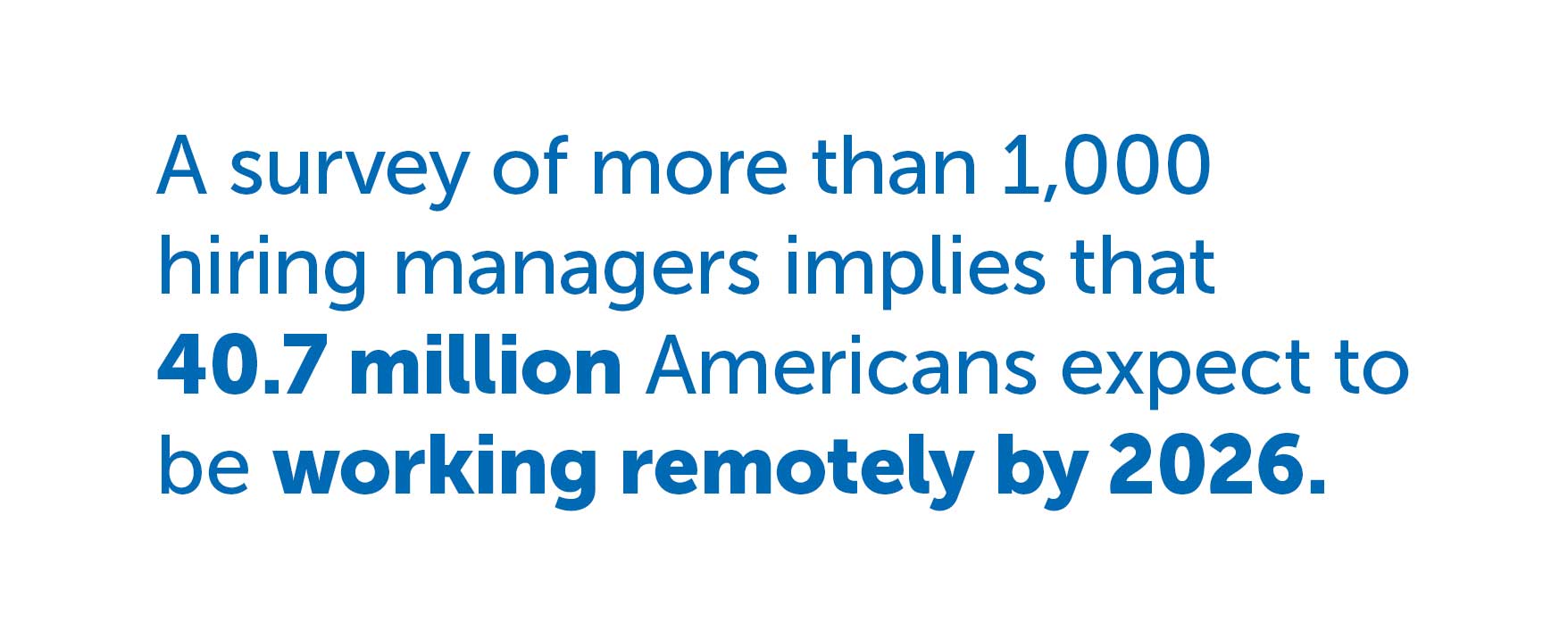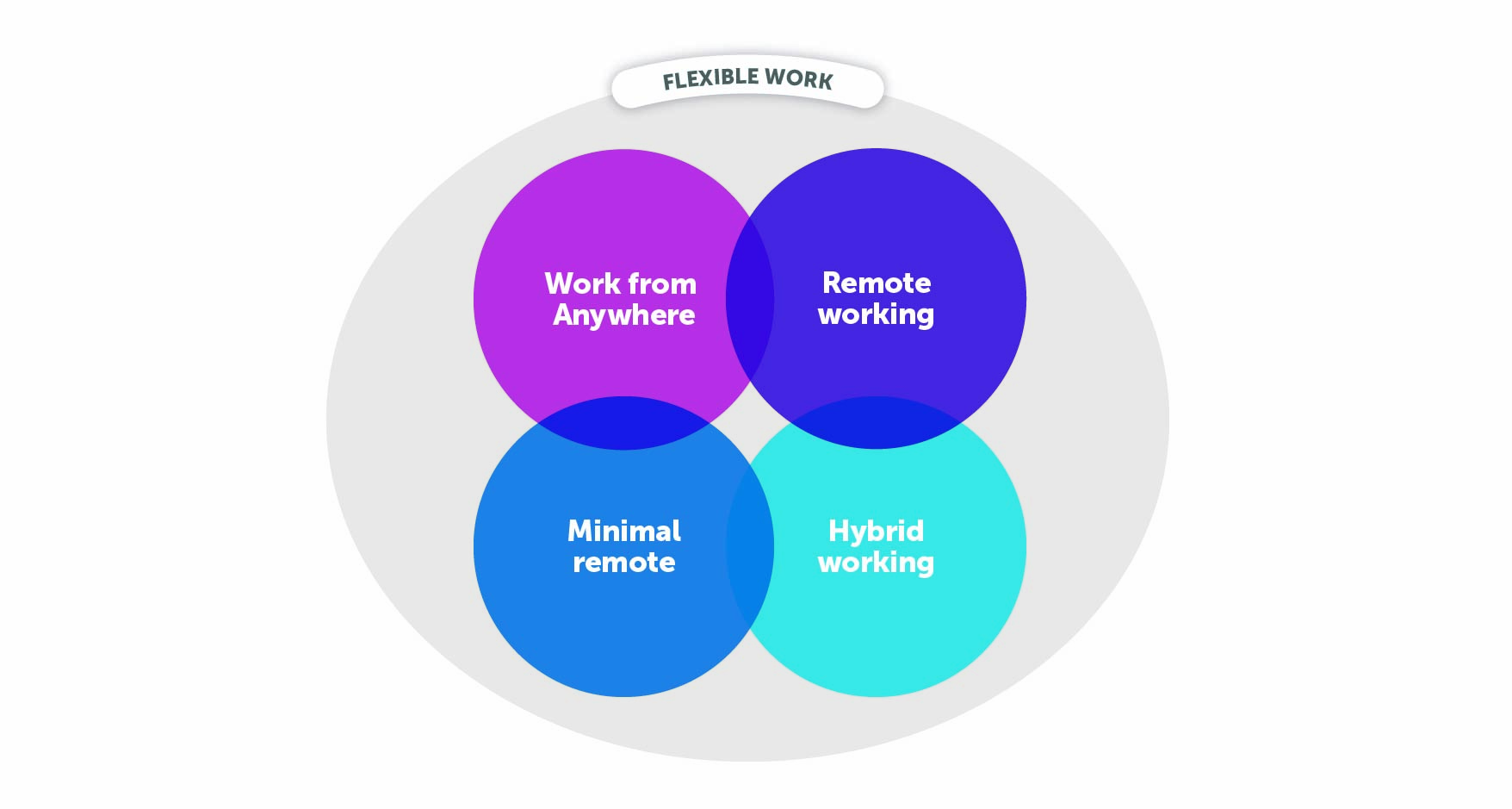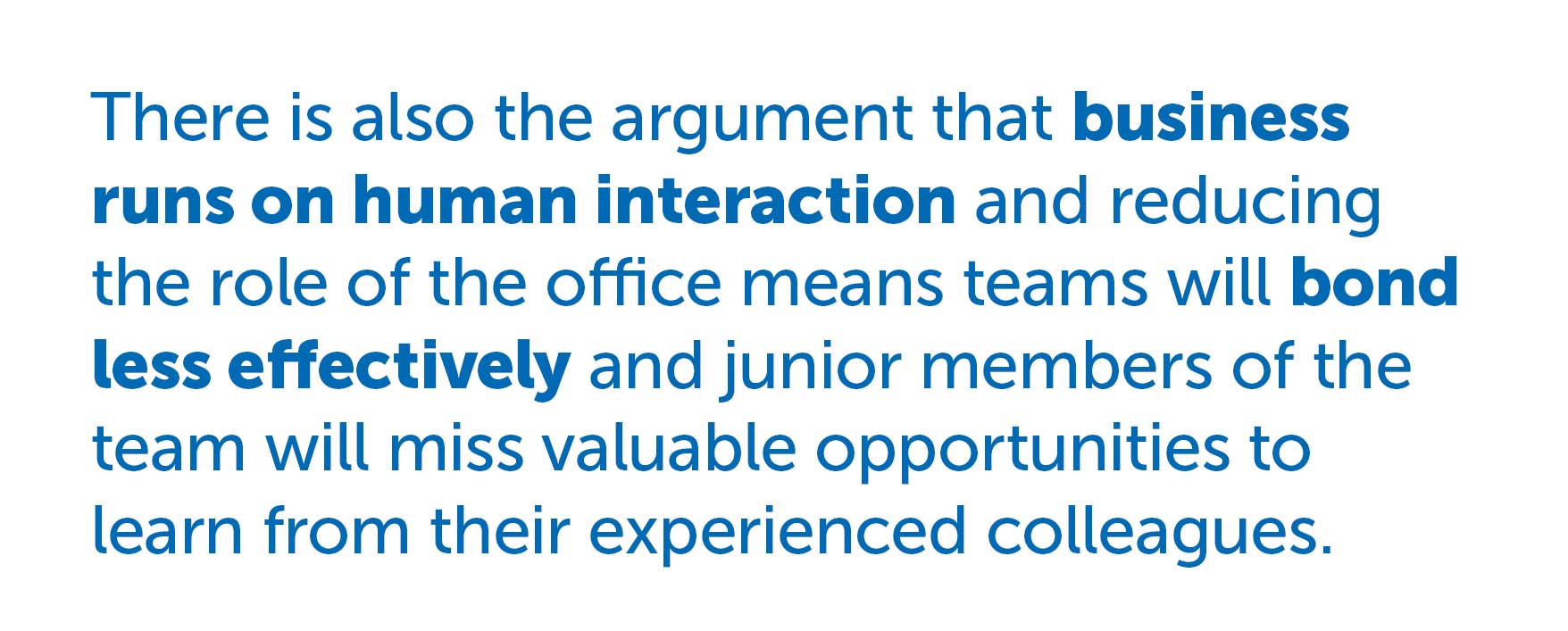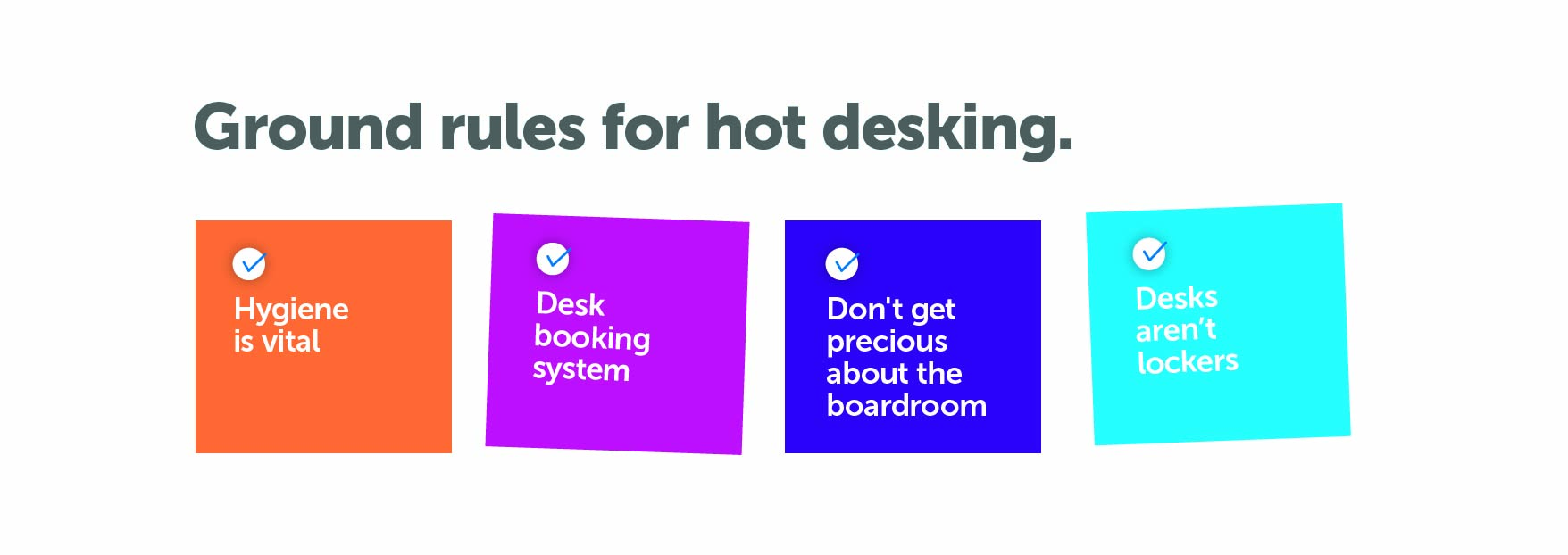
At Condeco we’ve considered hybrid spaces as the future of work for years, even before the global pandemic changed our lives. The arrival of COVID-19 was the catalyst for the flexible working model reaching the top of our business agendas and it’s now an issue few can ignore. In this article we take a look at what flexible working entails, the different models available, why hybrid working may be your best options and best practice for implementing hybrid working in your business.
The paradigm shifts
When many people were forced to work from home they got their first taste of a different way of doing things. Lots of people have found this to be a better way, realizing that the office isn’t the only place where we can do business. Flexible working showed them a future where life and work finds a better balance and the daily commute is replaced by extra productive work hours and the chance to deal with domestic issues.
Of course, for others working from home has been a less positive experience. Instead it was a time of disruptions as children stayed off school, broadband failed to work and too many hours were spent on Zoom calls.

A survey of more than 1,000 hiring managers implies that 40.7 million Americans expect to be working remotely by 2026. So it seems like it’s not just a nice-to-have – the so-called ‘Great Resignation’ has created a war for talent and some of the best people are now demanding the option of flexible working as a deal breaker.
Although the virus continues to disrupt our society, many employers are now looking beyond the crisis and see flexible working as a permanent feature of their organizations. At the same time, the group who don’t love working from home so much also needs to be considered
In short, flexible working and the hybrid model is here to stay.
Different types of flexible working

Flexible working covers a wide spectrum of arrangements that are evolving all the time. However, whatever a business chooses to do, these arrangements can be broken down into four main models:
Work from anywhere (WFA) model
Put simply, this means nobody goes into the office, in fact there may not even be an office at all. And people can work from anywhere they like, when they want.
Instead everything is organized remotely – meetings, collaborations and communications. Slack, Zoom and Teams have all become major tech tools since the start of the pandemic and technology continues to evolve to make this option a workable possibility. Of course, the full WFA model is not suitable for every company and those involved in manufacturing or service industries simply won’t be able to adopt it. For knowledge based businesses, for example accountants or software developers, it certainly can be done and is being done around the world.
Remote model
This less extreme of the WFA model is where it is down to the individual employee to decide how and when they work. For some people, the bustle and energy of the office is a far more attractive proposition than sitting at home every day, distracted by domestic duties. Few companies can offer this option without some caveats and rules around attending meetings etc. But for smaller businesses the freedom to choose can seem both fair and attractive to potential employees.
Minimal remote model
In this case, a business decides that remote working really won’t fit into its way of doing business where close proximity is required to get things done or to make customers happy. That means some form of remote working may be available but would be dependent on a line manager’s approval on a case by case basis. There may also be some wiggle room in offering more flexible work schedules or alternative offices that reduce commute times. Minimal remote working is often the starting point for a company’s journey to something more comprehensive.
Hybrid model
This is probably the most popular option where employees combine both office and home during their working week. The most widespread balance seems to be 3 days remote and 2 days in the office but every business is different and so are mixed models. In our opinion this is likely to be the route the majority of businesses go down in a remote working future. Although it may seem straightforward there are still challenges to be faced in terms of arranging meetings, how to conduct mixed meetings and choosing days when remote working is an option. However, it does seem to offer a ‘best of both worlds’ arrangement and is attractive to staff and business leaders alike.
The benefits of the hybrid model

Employers shouldn’t be forced into flexible working by popular opinion but see it as a chance to give their business a positive boost. Whilst circumstances may have made hybrid working a necessity there are some very good reasons for continuing the arrangement even in a future when hybrid working is hopefully an option rather than a crisis management tool.
One of the massive benefits of the hybrid model is that the employees can use the office to better collaborate, network, socialize, learn and develop. This interaction gives it an advantage over other arrangements where office space is removed entirely. Other advantages include:
- Happier employees – getting the right balance between work and home life is a challenge employers have been wrestling with for decades. Remote working allows individuals to choose the balance that works for them and happier staff means more productive staff.
- Productivity – some people spend hours every day on a train or in a car when they could be working on one of your challenges. Remote working can give them those hours back to your benefit with fewer travel costs for them.
- Planet friendly – you can reduce your energy costs and help the environment at the same time by managing an office that uses fewer resources and isn’t running 24/7. A reduction in commuters and office space also means a reduction in CO2.
- Safety – if you’ve been faced with the challenge of implementing Covid-related hygiene measures in your office then remote working makes things easier by reducing the headcount in work spaces and making social distancing easier.
- Improved collaboration – remote working tech has just got better and better and it could well be that it delivers more effective meetings and efficient ways of collaborating online.
- Deep work – a hybrid work from home model can help some people focus more intently on their biggest challenges without being interrupted by quick chats or loud colleagues. That means better work outcomes for your business.
- Flexibility – a hybrid working model allows you to hire from around the world and meet up anywhere you like. Remote working also opens up the possibilities for a business that goes beyond the bounds of geography and office space.
The case against hybrid working
Let’s be fair and look at the other side of the argument. Hybrid working can seem too big a leap for many businesses. There is a suspicion among some employers that when people work at home they take advantage of the situation and spend more time doing housework than dealing with business issues. After decades of direct control, not knowing what staff are doing at any point in time can seem scary.

There is also the argument that business runs on human interaction and reducing the role of the office means teams will bond less effectively and junior members of the team will miss valuable opportunities to learn from their experienced colleagues. We also underestimate the number of people who actually enjoy going into the office and they may consider that the fun and social aspects of work life have disappeared with a hybrid working model.
These are legitimate concerns but the past few years has shown that remote working hasn’t led to a reduction in productivity. In some cases people are working harder than ever with normal office hours becoming more flexible. Getting the job done has been more important than an obsession with presenteeism. In fact, remote working may be encouraging some to work too hard.
Remote meetings have also fostered closer relationships and brought people together who may have rarely met for reasons of geography or mobility. It has also made actual time in the office feel more special and important. Face to face meetings are no longer a daily drudge but moments to connect and form closer bonds. More gets done when you only occasionally get together.
What to consider when moving to a hybrid working model
For some, the shift to hybrid work from home model will feel natural and fairly straightforward – especially if the business was already contemplating such a move before the pandemic and discovered how it could work effectively during the long months of lockdown.
For others who are seriously considering remote working as a long term option, there are a number of factors that need to be considered. Many of these revolve around communicating with your staff and empowering them with the technology to make remote working simple and convenient. For example, mobile apps can put greater flexibility in the hands of employees and the right desktop software can coordinate the moving parts of a remote working business.

The key to making the hybrid model work is control. Without that it can lead to chaos where no-one has the time to focus on the work activities that result in better outcomes. When you have control, employees and employers can then focus on adding value.
As more and more employers adopt a flexible approach, there is an increasing amount of guidance on hybrid work model best practices and not just from the usual suspects such as Microsoft and Google who have the huge resources to make the change more easily.
A little research into what has worked for others can inspire you to make the right decisions. By reading the case studies you will see how remote working can work for any business.
How to do hot desking
Let’s tackle a practical issue facing many businesses adopting a hybrid work model – hot desking.
When people are coming into your office at different times it can be hard to justify a permanent space or desk for them. True, those in sensitive departments such as HR will need more private spaces. And it’s also human nature to try and establish our little bit of real estate in every office – our desk where we like to work.
But if you are adopting hybrid working then some form of flexible desk arrangement, or hot desking, is likely to be necessary.
There are advantages in terms of making better use of your office space and encouraging a more agile way of working. What is required is the establishment of some ground rules to make it effective:

- Hygiene is vital at the moment – people need to know what’s expected of them in terms of leaving a tidy, uncluttered desk. What’s your cleaning arrangement in terms of wiping down sources and removing the danger of passing on viruses?
- A desk booking system can prevent turf wars or arguments about ‘my space’. There are apps available which make it simple for people to book in advance so they know where they are sitting when they arrive in the office. It’s the same case with booking meeting rooms and there are tech solutions to ensure your system works effectively for everyone.
- Don’t get precious about the boardroom. If you have got spaces that people can use for confidential meetings then open them up to a wider audience, freeing up other desk space.
- Desks aren’t lockers – a clean desk policy should also cover drawers. Don’t allow people to store personal belongings, gym bags etc in desks used by others. You need to drive home the point that the desks are for everyone no matter who they are.
Communication is key
Introducing a hybrid working policy is a big step and you need to take your employees with you on the journey. Before deciding on anything, it is a good idea to carry out a survey to gauge your people’s attitudes towards working at home and in the office. A large percentage may actually want to work at your HQ full-time. If so, adopt your policy accordingly.
When you have decided on a course of action, set out your reasons and rules clearly. You will need everyone on board to make this work. It will also be important to decide on rules of etiquette for various situations such as:
- Meetings – if some are working remotely and some are in the office how can you ensure those not attending in person don’t feel left out of conversations?
- Clients and customers – are there times when you can insist on people being present such as meetings with important customers or vital strategy sessions?
- Technology – broadband dropouts and aging equipment can be a blocker on remote working. Do your colleagues have a right to a certain level of equipment?
- Health and safety – for those staff working at home you still have a duty of care to ensure they are using safe equipment. Can you provide assistance with a home office setup and carry out remote checks on electrics etc. Are you looking after their mental well-being?
- Dress code – we may live in a modern, more relaxed society but turning up for a virtual meeting a dressing gown is still considered unprofessional. Do you insist on what your staff can wear in certain situations?
None of these issues is irresolvable and much of it is down to common sense. But ensure that everyone is fully aware of the rules and standards and the rationale behind them.
Thinking beyond Zoom

Remote video meetings have become a staple for people’s lives since the start of pandemic. Most of us have had the opportunity to see the bedrooms, kitchens and living rooms of our colleagues. But to make remote working effective make sure that video is not the only channel for communication.
Real time messaging services such as Slack can offer a way of keeping in touch, asking questions and discussing issues without the need to turn on the camera. Even good old fashioned email has a place in this new world order.
Not everyone loves the on-screen life so don’t rule out telephone calls for colleagues who are struggling with the new tech. Create online forums, look into collaborative online tools such as Google docs and make it known that you want everyone to feel comfortable in how they communicate.
Are you ready for hybrid working?
Hybrid working is not just a trend but a reality for many businesses. Wherever you are on your journey you need to approach this area in the spirit of evolution and constant change. What works this month may not be so effective in two years’ time. Embrace the benefits of remote working but also face up to the challenges.
Investigate the workspace tech that’s now available to make remote working a benefit for your business. At Condeco we offer solutions such as:
- The ability to book workspaces as and when you need them.
- Integrate calendars with room booking software.
These solutions are designed to create a frictionless experience for your workforce. We think you will find that there is a solution for all the challenges you face and creating a tech driven office that works the way you work is within reach of any business of any size.
As more and more people start to return to work, now is the time to embrace flexible working before old routines start to harden once again. Seize the moment and make your business a better, more efficient and human place to work.



